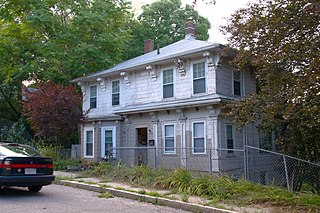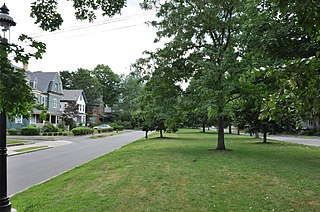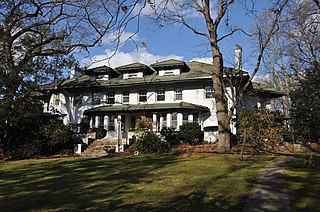
The Seth Adams House is a historic house at 72 Jewett Street, in the Newton Corner village of Newton, Massachusetts. Probably built in the mid-1850s, it is a well-preserved example of Italianate architecture. During the 1870s it was home to Seth Adams, one of Newton's wealthiest residents. The house was listed on the National Register of Historic Places in 1986.

The House at 68 Maple Street is an historic building located on the corner of Maple Street and Nonantum Road in the village of Newton Corner, in Newton, Massachusetts. Built in the late 1840s, the two-story wood-frame building is a rare local example of a vernacular square hip-roofed Italianate house. Its most prominent features are its overscaled brackets, which decorate both the extended eaves and the roof line of the bay on the front facade.

The Washington Park Historic District is a historic district in the village of Newtonville, in Newton, Massachusetts. It includes the following properties, dating to between 1870 and 1900: 4 to 97 Washington Park plus 5 and 15 Park Place. The focal point of the district is the city park which is located in the median of the street of the same name. On March 12, 2008, it was added to the National Register of Historic Places.

The General Rufus Putnam House is a National Historic Landmark at 344 Main Street in Rutland, Worcester County, Massachusetts, US.

Our Lady Help of Christians Historic District encompasses a complex of Roman Catholic religious buildings in the Nonantum village of Newton, Massachusetts. It includes four fine examples of brick Gothic Revival architecture: the church, convent, and rectory, as well as Trinity Catholic High School. The first three buildings were designed by noted ecclesiastical architect James Murphy, and were built between 1873 and 1890. The high school building was built in 1924, also in the Gothic Revival style. The district was added to the National Register of Historic Places in 1986.

The Charles Newton House is a historic house at 24 Brattle Street in Worcester, Massachusetts.

The Emerson–Franklin Poole House is a historic house at 23 Salem Street in Wakefield, Massachusetts. Built about 1795, it was in the 19th century home to Franklin Poole, a locally prominent landscape artist. Some of its walls are adorned with the murals drawn by Rufus Porter. The house was listed on the National Register of Historic Places in 1989.

The William Blodgett House is a historic house at 11 Fairmont Avenue in the Newton Corner neighborhood of Newton, Massachusetts. Built about 1875, it is a prominent local example of Stick style architecture. It was listed on the National Register of Historic Places in 1986, where it is listed at 645 Centre Street.

The John Buckingham House is a historic house at 33–35 Waban Street in the Newton Corner village of Newton, Massachusetts. Built about 1864, it is a good local example of Second Empire architecture, typical of built at that time for upper middle class commuters to Boston. It was listed on the National Register of Historic Places in 1986.

The House at 3 Davis Avenue in West Newton, Massachusetts, is a well-preserved modest Italianate residence. It is a 2+1⁄2-story wood-frame house, three bays wide, with a front-facing gable roof. It was built c. 1853, and has an unusual amount of decorative trim for a modest house. The eaves and gables are studded with brackets, and the corners have quoining blocks. The front parlor windows, sheltered by a porch also studded with brackets, are of extended length.

The Samuel Jackson Jr. House is a historic house located at 137 Washington Street in Newton, Massachusetts.

The Joshua Jennison House is a historic house at located 11 Thornton Street in the Newton Corner village of Newton, Massachusetts.

The William F. Kessler House is a historic house at 211 Highland Street in Newton, Massachusetts. Built in 1913, the 1+1⁄2-story wood-frame house is a fine example of rustic Craftsman styling. The front roof slopes down to form a porch, which is supported by brick and fieldstone piers. The roofline is pierced by a multi-section dormer with varying window size, shapes, and roof lines. The house was built as infill in an already-developed part of West Newton Hill by Frank Kneeland, a local builder. William Kessler was a salesman.

The Rawson Estate is a historic estate house at 41 Vernon Street in Newton, Massachusetts. The 2+1⁄2-story wood-frame house was built c. 1860, and is a well-preserved surviving specimen of an Italianate estate house, a form which was once more common in the Newton Corner area. It has a symmetrical appearance, with a projecting central section with a gable in which a round-arch window is set. The front porch has ornate decorative wood trim. The house was built by Daniel Rawson, a boot and shoe merchant, and was once part of a much larger landholding of the Rawsons.

The Jonas Salisbury House is a historic house at 62 Walnut Park in Newton, Massachusetts. The 2+1⁄2-story wood-frame house was built about 1847, and was one of four temple-front mansions built in the Newton Corner area. Of these, it is the only one still standing. It has typical hallmarks of the Greek Revival style, with flushboarded facade, corner pilasters, and an entrance flanked by pilasters and set under a pediment. The property also includes a period carriage house. Jonas Salisbury was a significant property owner in Newton.

The S. Curtis Smith House is a historic house at 56 Fairmont Avenue in Newton, Massachusetts. The 2+1⁄2-story wood-frame house was built c. 1883, and is one of Newton's finest Queen Anne Victorian houses. It exhibits a full range of that style's features, including asymmetrical massing with numerous and varied gables, a tower with an octagonal arched roof, bands of different types of shingling, and an ornately decorated front portico. The house was built for S. Curtis Smith, a schoolteacher.

The Samuel Wheat House is a historic house at 399 Waltham Street in Newton, Massachusetts. It is a 2+1⁄2-story timber-frame house, five bays wide, with a gambrel roof and clapboard siding. The front entrance is flanked by pilasters and topped by a gabled pediment. The house was built c. 1735, probably for Dr. Samuel Wheat, Jr, and is one of the oldest houses in the city. It was probably built with the gambrel roof, but the dormers are a 19th-century addition.

The Frank H. Stewart House is a historic house at 41 Montvale Road in Newton, Massachusetts. The 2+1⁄2-story stucco-clad house was built in 1909 for Frank H. Stewart, a lawyer. It is located in an Olmsted-designed subdivision, and is one Newton's finest large Classical Revival houses. It has a green tile hipped roof with exposed rafter ends, pierced by three hip-roofed dormers. The main facade has a front porch that merges into two flanking single-story projecting bays, all also topped by a green tile roof. There are flanking side sections fronted by porches.

The S. D. Newton House is a historic house at 8 Sycamore Street in Worcester, Massachusetts. Built in 1846, it is an excellent local instance of Greek Revival styling, and one of the few houses surviving from that period in the neighborhood. which once had many more of such houses. The house was listed on the National Register of Historic Places on March 5, 1980. Unfortunately the current keeper of the home has let it go. Not much original left. Garbage everywhere on the inside. Lead paint, peeling paint. An eyesore it has become. It once was a great piece of local history.

The Charles Maynard House is a historic house at 459 Crafts Street in Newton, Massachusetts. The house was built in 1897, and is a fine local example of a Queen Anne Victorian with some Colonial Revival styling. It is also notable as the home of naturalist and taxidermist Charles Johnson Maynard. The house was listed on the National Register of Historic Places in 1996.






















